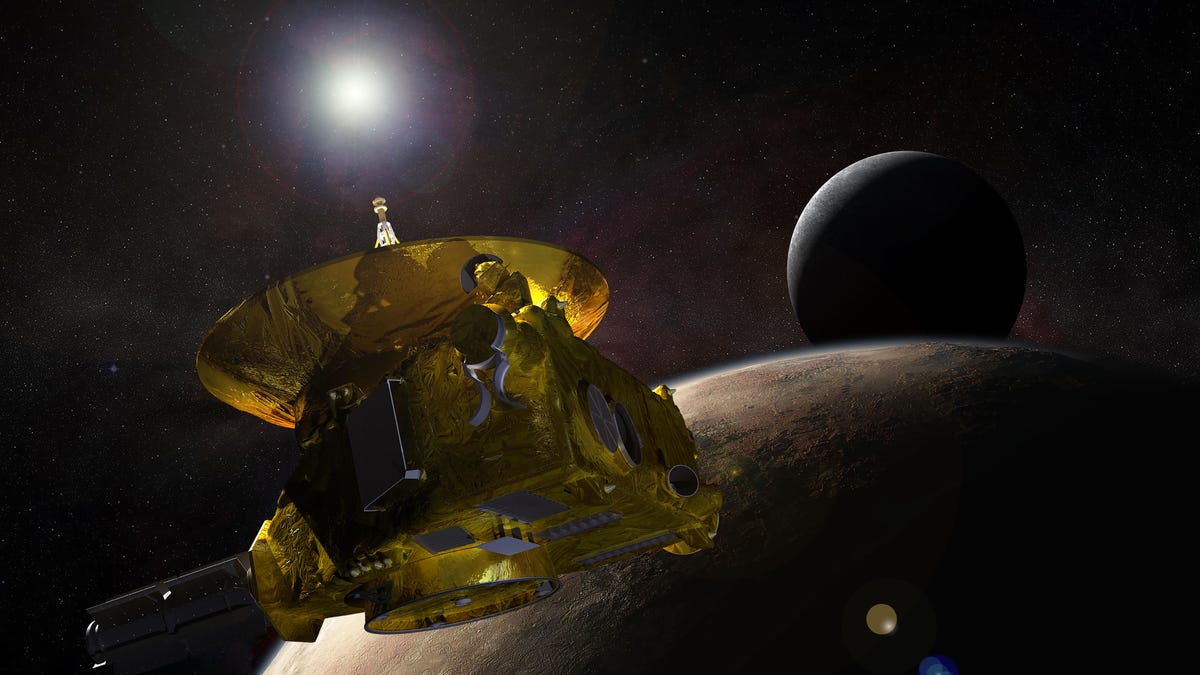NASA to spend New Year's exploring a frozen, hostile space rock
If your New Year's resolution is to travel 4 billion miles to explore the very edge of the solar system, NASA has you covered.

An artist's rendering of the New Horizons spacecraft.
While you're washing the glitter out of your hair and trying to ward off that post-New Year's Eve headache, NASA's New Horizons mission will spend the first day of the year exploring farther out in the solar system than we've ever explored before.
New Horizons is NASA's mission to explore the outer reaches of the solar system and learn about the origins of its formation. Launched in January 2006, the spacecraft has travelled billions of miles, past Pluto and into the ring of icy bodies called the Kuiper Belt that's roughly a billion miles beyond the orbit of Neptune. (The Kuiper Belt extends between 30 and 55 astronomical units from the sun. An AU is the distance between Earth and the sun.)
In this week's episode of Watch This Space, we take a look at New Horizons' mission goals, and what scientists hope to learn from one particular icy, space rock: the Kuiper Belt Object (KBO) known as 2014 MU69, or Ultima Thule.
New Horizons isn't exactly new
The space probe has traveled roughly 4 billion miles since its launch. It made headlines in 2015 when it did the first ever flyby of Pluto, sending back beautifully detailed images of the ice dwarf's surface and giving us the closest-ever look at the former ninth planet of the solar system.
Pluto as seen in an enhanced color view from NASA's New Horizons.
Where is New Horizons going?
In the early hours of Jan. 1, 2019, New Horizons will fly by Kuiper Belt Object 2014 MU69. The icy body is 100 times smaller than Pluto and is roughly 46 astronomical units from the sun at its farthest point. It was discovered by the Hubble Telescope in 2014 (hence the year in its title) but NASA gave it the nickname Ultima Thule after a public vote. Ultima Thule means "beyond the borders of the known world," which is a fitting description of an object orbiting 1 billion miles beyond Pluto.
New Horizons is exploring the very edges of our solar system.
We've been here before, right?
NASA has certainly been through the Kuiper Belt before. The space agency's twin Voyager space probes passed through the icy ring at the edge of the solar system in the '90s on their way out to deep space. But we didn't know about the Kuiper Belt until 1992 and by that time, according to New Horizon's principal investigator Alan Stern, Voyager 2 was deep within it and Voyager 1 was almost all the way across. With New Horizons, NASA is getting up close and personal to really explore the region in depth.
This artist's concept shows one possibility for the shape of Ultima Thule.
What will Ultima Thule teach us?
We don't know much about Ultima Thule now. For example, we don't know if it has rings, an atmosphere or moons. In fact, we don't even know whether it's one or two objects. But NASA believes the space rock was formed between 4.5 billion and 4.6 billion years ago and has been hanging out in conditions approaching absolute zero since then. That means it could shed light on the formation of the solar system and how we all got here from our humble solar nebula beginnings.
What's next?
Before the flyby, you can sign up to beam a greeting, alongside your name, to New Horizons when it reaches its destination. And you can stay up to date with the latest news through the New Horizons' Twitter feed.
And after the flyby? NASA will wait to get data back from New Horizons (it's currently about a 12-hour round trip for communications, according to Project Manager Helene Winters) to find out about its surface composition, atmosphere, temperature and more. And from there, the New Horizons team has set its sights on finding another KBO to map even further out.
NASA turns 60: The space agency has taken humanity farther than anyone else, and it has plans to go further.
Taking It to Extremes: Mix insane situations -- erupting volcanoes, nuclear meltdowns, 30-foot waves -- with everyday tech. Here's what happens.

